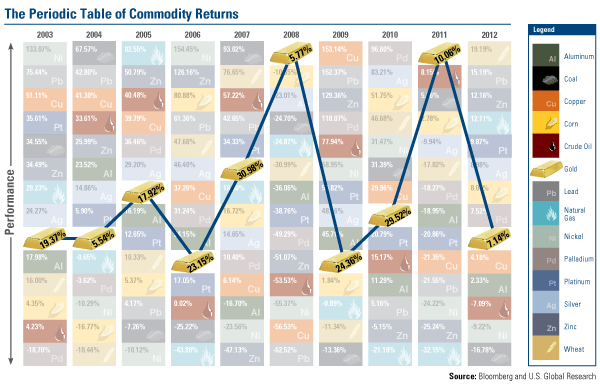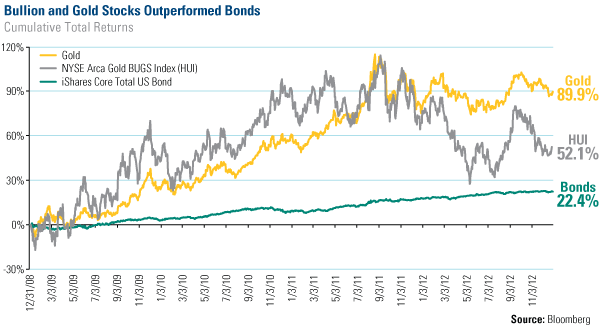Register to “Follow the munKNEE“ and automatically receive all articles posted
Our ever-popular Periodic Table of Commodity Returns has been  updated through 2012. It shows a decade of results across 14 different commodities, providing strikingly rich information in a very insightful format.
updated through 2012. It shows a decade of results across 14 different commodities, providing strikingly rich information in a very insightful format.
So writes Frank Holmes (www.usfunds.com) in edited excerpts from his original article* entitled 4 Sensational Facts About Gold Investing That You Might Not Know.
This article is presented compliments of www.FinancialArticleSummariesToday.com (A site for sore eyes and inquisitive minds) and www.munKNEE.com (Your Key to Making Money!) and may have been edited ([ ]), abridged (…) and/or reformatted (some sub-titles and bold/italics emphases) for the sake of clarity and brevity to ensure a fast and easy read. Please note that this paragraph must be included in any article re-posting to avoid copyright infringement.
Holmes goes on to say in further edited excerpts:
11 Commodities Rose in Value
Last year, 11 commodities rose in value, with wheat rising as the top crop after seeing a significant decline in 2011. It was a similar rags-to-riches story for the next few leaders: lead, zinc, natural gas and platinum all climbed double digits in 2012 after falling in 2011.
3 Commodities Declined in Value
- Crude oil fell by 7% (after rising 8% the previous year).
- Nickel fell 9% (after falling 245 in 2011).
- Coal fell nearly 17%, the 4 time in 5 years (rising 31% in 2010)….
As you can see from the Periodic Table of Commodity Returns, commodities often have wide price fluctuations from year to year given the many factors affecting supply and demand, such as government policies, union strikes, and currency volatility.
When it comes to commodities and commodity producers, many investors “leave the driving” to active money managers who understand these specialized assets and the global trends affecting them. Take gold and gold companies, for example. After investing in the mining industry for decades, we’ve taken note of several facts about gold that continue to surprise our investors. Here are four of the latest:
1. Gold Has Been A Consistent Performer Over The Decade
While gold did not shoot the lights out in 2012, its bull rally goes on. It ended the year up 7%, making it a phenomenal 12th year in a row that gold…[has risen] in value. In a special gold bar version of the Periodic Table below, you can easily see gold’s rotation among the commodities from year to year.
What’s fascinating is the three-year rising pattern relative to other commodities that emerges when you focus on the bars. Over the past 10 years, gold has risen in position compared with the others for three years in a row, then fallen in relative position in the fourth year before repeating the cycle. Will it follow the same pattern and be in the top half of the Periodic Table in 2013?

2. Gold Should Remain A Hot Commodity In 2013
Considering the global easing cycle and the continuous running of monetary printing presses, I believe the Fear Trade will continue to be a driver of gold over the next several months. Take a look at the projected rise in the balance sheets as a percent of GDP from the European Central Bank, the Bank of Japan, the Federal Reserve and the Bank of England over 2013. The ECB is estimated…[that it will] have a balance sheet that is nearly 50% of its GDP by the end of the year. The Bank of Japan is right behind the ECB, with its balance sheet projected to be nearly 35% of GDP. As Mike Shedlock of Mish’s Global Economic Trend Analysis said, “The race is on to see which central bank can load up its balance sheet with the most garbage the fastest.”

Ian McAvity also summed it up well in his Deliberations on World Markets: “Gauging from the panicky actions of the major central banks, I would still prefer to own gold than their paper.” With the monetary printing presses warm and real interest rates in the red, gold will likely glimmer for another year.
3. Gold Is The Least Volatile Commodity On The Table
Given the fact that every gold move is analyzed and dissected by the media, it may surprise you that this precious metal was actually the least volatile of the 14 commodities. Its rolling 12-month standard deviation (sigma) over the past 10 years has been 14%, compared to the most volatile commodity, (nickel), which has a rolling 12-month sigma of nearly 60%.
Here’s another way to look at the surprisingly low volatility of gold. Take a look at the frequency of 10% moves up or down over any 20 trading days. The metal is only slightly more volatile than the S&P 500. Gold companies, crude oil and the MSCI Emerging Markets Index have all experienced more up and down moves than gold.
| Number of +10% Moves | Number of -10% Moves | Frequency of ±10% Moves | |
|---|---|---|---|
| NYSE Arca Gold BUGS Index (HUI) | 490 | 296 | 30% |
| WTI Crude Oil | 434 | 302 | 29% |
| MSCI Emerging Markets (MXEF) | 139 | 169 | 11% |
| Gold Bullion | 130 | 60 | 7% |
| S&P 500 Index (SPX) | 33 | 72 | 4% |
Whereas card counting at a Blackjack table can get you booted from casinos and barred for life, as an investor, you are allowed to take full advantage of counting the 10% moves.
Over 2013 you can count on gold moving in either direction, so even if the metal experiences extreme volatility to the downside, regardless of what the headlines report, any dip in price offers potential buying opportunities. Keep in mind though, that it’s prudent to invest only 5 to 10 percent of your total portfolio in gold and gold stocks.
4. The Last 4 Years Were Better Than You Thought
…As you can see below, the NYSE Arca Gold BUGS Index (HUI) experienced quite a gain, increasing 52.1% on a cumulative basis since the beginning of 2009. While excellent it pales in comparison to the 89.9% in Gold it…considerably outperformed the iShares Core Total US Bond ETF which realized only 22.4% during the same period.

Editor’s Note: The author’s views and conclusions are unaltered and no personal comments have been included to maintain the integrity of the original article. Furthermore, the views, conclusions and any recommendations offered in this article are not to be construed as an endorsement of such by the editor.
*http://www.usfunds.com/investor-resources/investor-alert/4-sensational-facts-about-gold-investing-that-you-might-not-know/
Register HERE for Your Daily Intelligence Report Newsletter
- It’s FREE
- Provides the “best of the best” financial, economic and investment articles to be found on the internet
- Is in an “edited excerpts” format to provide brevity & clarity to ensure a fast & easy read
- Don’t waste time searching for informative articles. We do it for you!
- Register HERE and automatically receive every article posted
- “Follow Us” on twitter & “Like Us” on Facebook
Related Articles:
1. Nickel: Demand Strong, Supply Diversified & Prices Stable
While best known for its use in the five cent coin, nickel has far more strategic uses. Nickel can be alloyed with other metals to create truly extraordinary materials – such as stainless steel which now accounts for more than half of all nickel consumed. China’s stainless steel consumption has increased 1625% in the last 10 years and is now the largest demand driver for nickel worldwide accounting for 40% of global totals. There’s still a lot more room for growth in the industry and nickel’s diversified supply is expected to keep prices stable, so the savvy investor should look for low cost nickel projects in safe jurisdictions. Check out the infographic below for more insights.
2. Why Copper Prices Have Increased So Dramatically Over the Last 10 Years
In this infographic we explore why copper prices have increased by 4x over the course of 10 years.
3. Grantham: Paradigm Shift Taking Place In Commodity Prices
We are undergoing a Paradigm Shift in the price trend of virtually all commodities – perhaps the most important economic event since the Industrial Revolution. [Let me explain why that is the case.] Words: 765
The biggest danger to our society will be food prices and food costs….Productivity of grains has fallen to 1.2% per year which matches population growth exactly leaving society with no safety margin. [In addition,] there is a coming shortage of two fertilizers which occur exclusively in nature…so once the supply is gone, it’s gone forever – and this can only mean that commodity prices are going higher – much higher. Words: 585
5. Major Investment Opportunities Exist In Agriculture! Here’s 50
The agriculture sector has long been a popular place for commodity trading. After all, it was with agricultural futures that commodity trading got its start. Farmers had originally used these contracts to help offset any losses in crop yields. Now, the agricultural space has blossomed into a market chock full of options for investors, but many investors are still unaware of the vast opportunities that this sector offers. [Let us change all that!] Words: 2376
6. The “Ins” and “Outs” of Investing in Commodities
Commodities have obvious appeal to active investors looking to generate profits from short-term price movements [but while] the volatility of this asset class is ideal for risk-tolerant individuals who actively monitor their positions…commodities may also have appeal to the long-term, buy-and-hold crowd…These potentially appealing attributes come with plenty of risk, [however, as] the path to commodity exposure is full of potential obstacles and pitfalls that can erode returns and lead to a less-than-optimal investing experience. Here are ten rules of thumb that will help you achieve a more successful experience investing in commodity markets. Words: 2871
7. Certain Hard Commodity Prices Will Drop By As Much As 50% By 2015 – Here’s Why
I have been bearish on hard commodities for the past two years and, while prices may have dropped substantially from their peaks during this time, I don’t think the bear market is over. I think we still have a very long way to go and there are four reasons why I expect prices to drop a lot more. Words: 3978
8. Outlook Mixed for Gold, Silver & 12 Other Major Commodities
In Morgan Stanley’s latest update to their Commodity Manual, the commodities team, led by Hussein Allidina, continue to be most bullish on gold, soybeans and corn. Below is their outlook for those and 11 other commodities. Words: 700
9. Interested In What Oil Prices Will Be In 2013 – and Why? Then This Article Is For You
Economics will dictate that you can only build so much storage to avert a price drop from continual over-supply and, right now, the world produces more Oil than it consumes each day, and it has for the past 16 months. This trend will only get worse so expect prices to finally start to address this over-supply issue in the Oil markets in 2013. [Let me explain further.] Words: 1640
 munKNEE.com Your Key to Making Money
munKNEE.com Your Key to Making Money





